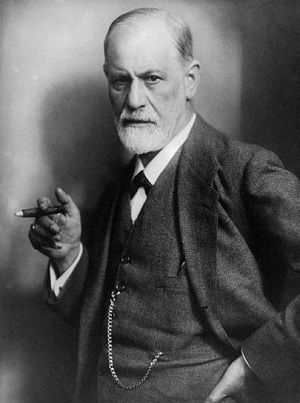A Practice Reading Test:
Prepare for the TOEFL or IELTS
Use the discussion before and after this practice reading test to help you know what to look for when you take reading tests like the TOEFL or IELTS exams.
(If you would like to print this explanation and exercise and work offline, (right}-click here for a downloadable pdf.)
When taking a reading test,you need to understand exactly what each question is asking, and then to find the information in the reading concerning that question.
Skim this paragraph on Psychodynamic Therapies. (Therapies are ways to treat or help people with problems. Psych- refers to the mind, and dynamism refers to active change, so these therapies help people with mental problems to change or overcome them.) Then think about what you already know about Freud and his theories. Have you heard of any of the psychotherapies mentioned?
(You should not answer any questions based on your prior knowledge, but thinking about it helps you focus on the reading. It may remind you of some words you had learned but forgotten. It will also help you pay attention to new information.)
Read the questions over quickly. Then read the article again with the questions in mind. Now read question #1 and its possible answers carefully. Search the paragraph for the relevant information.
When you think you have found the answer, read the question again. Be sure you understand exactly what it is asking for. Choose the best answer, double-checking that it matches the information in the text and that it answers the question. (Sometimes tests have “answers” that are true but are not quite what the question is asking for. See answers to questions #1 & 6 in this reading test for examples.)
After you have finished answering the questions, check your answers and read the discussion below for any that were confusing to you.
 Sigmund Freud
Sigmund Freud“The first major approach to psychotherapy was developed by Sigmund Freud and is called psychoanalysis (Horowitz, 1988). Since its origin more than a century ago, psychoanalysis has undergone many changes. Today, Freudian (or classical) psychoanalysis is still practiced, but other variations have been developed—ego psychology, object relations theory, interpersonal psychology, and self-psychology, each of which can be grouped under the general term “psychodynamic” (Horowitz, 1988).
The psychodynamic therapies, even though they differ somewhat in theory and approach, all have some concepts in common. With each, the role of the past in shaping the present is emphasized, so it is important, in understanding behavior, to understand its origins and how people come to act and feel as they do. A second critical concept common to all psychodynamic approaches is the belief in the unconscious, so that there is much that influences our behavior of which we are not aware. This makes the process of understanding more difficult, as we often act for reasons that we cannot state, and these reasons often are linked to previous experiences. Thus, an important part of psychodynamic psychotherapy is to make the unconscious conscious or to help the patient understand the origin of actions that are troubling so that they can be corrected.”
(Emphasis added.) This is from “Mental Health: a Report of the Surgeon General.”) For the full report see the Mental Health Report.
Practice Reading Test
Choose the best answer:
1. When was psychoanalysis developed?
- A. in the 18th century
- B. more than 100 years ago
- C. a little less than 100 years ago
- D. by Sigmund Freud
2. What is the relationship of developed—ego psychology, object relations theory, interpersonal psychology, and self-psychology to classical psychoanalysis? They are
- A. very different therapies that preceded psychoanalysis.
- B. contrary theories developed in reaction to psychoanalysis.
- C. related therapies that followed psychoanalysis.
- D. related therapies that led to the development of psychoanalysis.
3. Paragraph 2 contains the words “to understand its origins.” ‘Its’ refers to:
- A. the role of the past
- B. the present
- C. understanding
- D. behavior
4.’Critical’ in this paragraph means
- A. finding fault
- B. extremely important
- C. interesting
- D. related to Higher Criticism
5. ‘The belief in the unconscious’ here refers to
- A.the idea that some mental processes occur outside a person’s conscious control.
- B.the belief that when a person is unconscious they are not aware of their environment.
- C.the conviction that people are unaware of much that happens around them.
- D. the idea that when people are sleeping their behavior may be strange.
6. According to the psychodynamic therapies,
- A.people’s previous experiences are not really important to understand.
- B. people’s minds and bodies work together.
- C. some people’s previous experiences are unpleasant.
- D. people don’t always understand the reasons for their actions.
7. Which of the following is NOT a goal of these therapies?
- A. to help patients be more cheerful and kind.
- B. to help patients recognize the roots of their behavior.
- C. to make patients conscious of the hidden part of their thinking.
- D. to enable patients to understand why they do what they do, so they can act differently in the future.
8. From the second paragraph we can infer that psychodynamic therapists try to help their patients understand the reasons behind their behavior in order to
- A. make a better world.
- B. enable them to change some things in their lives.
- C. free them from all anxiety in the future.
- D. advance the cause of science.
Answers and discussion of the reading test questions
1. B. This question is directly answered in the article text if you understand the meaning of ‘since’ (from a certain time), ‘origin’ (beginning), & ‘century’(100 years). Answer D “by Sigmund Freud” is true, but it doesn’t answer ‘when.’
2. C. This answer is also given clearly in the article. (Contrary means opposing.) The last sentence in the first paragraph calls them “variations that have been developed.” The first sentence makes clear that Freud’s (also called classical in the third sentence) was the first of these therapies.
3. D. ‘Behavior’ is the noun immediately preceding ‘its.’ It is the only possible antecedent (noun a pronoun refers to) in this case. (Sometimes finding the antecedent can be difficult. Read the sentences involved carefully, and remember that singular pronouns must refer to singular nouns, and plural PNs to plural Ns.)
4. B is the only likely meaning in this case, although ‘critical’ can also have the other meanings.
5. A. “The” unconscious refers to the part of the mind outside ordinary awareness.B & D refer to being unconscious, an adjective describing a condition in which a person is unaware of their surroundings. C is not really talking about being unconscious at all, although sometimes we speak of unawareness as not being very conscious of what is happening.
6. D is a restatement of the article. A is false according to psychodynamic theory, and B & C are true but not related to the theory according to the discussion in this article.
7. A. The article never mentions cheerfulness, kindness, OR trying to change the patient’s personality in any way. The other three choices all refer in different words to the goal stated in the article: “Thus, an important part of psychodynamic psychotherapy is to make the unconscious conscious or to help the patient understand the origin of actions that are troubling so that they can be corrected.”
8. B. An inference is based on information that is not stated but is clearly implied by what is written. A, C, & D are grand goals, but there is no mention or even hint of them in the text. They are all too grand for the question-- more than a therapist could reasonably hope to accomplish just by helping a patient understand himself better.
(You should also be wary anytime you see the words ‘all,’ ‘always,’ ‘none,’ or ‘never.’ Very few things in life are that absolute. So when answer C suggests “free them from all anxiety in the future,” that is clearly an unrealistic goal, besides not even being hinted at in the article.)
See Practice for Reading Tests for practice with a selection on American history.
home> English Language Test Prep> A Practice Reading Test.
Didn't find what you
needed? Explain what you want in the search box below.
(For example, cognates, past tense practice, or 'get along with.') Click to see the related pages on EnglishHints.
| site search by freefind | advanced |





